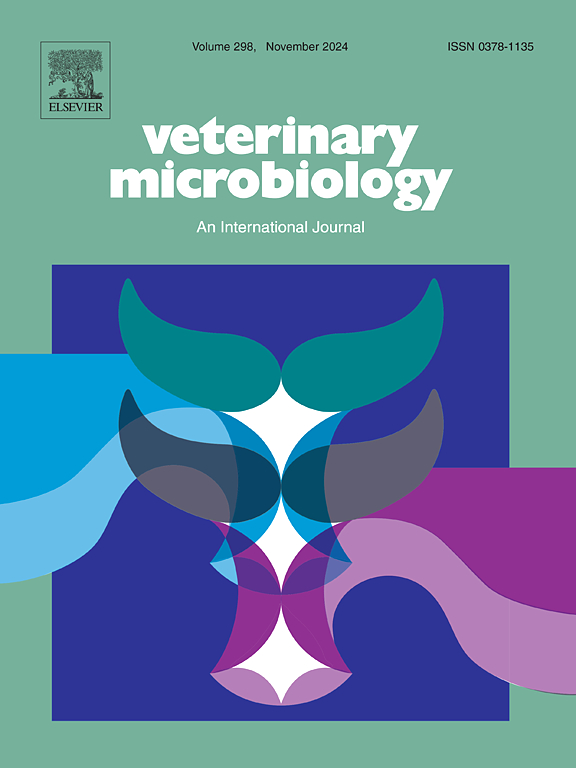Efficacy of an optimal vaccination strategy for H120 and NNA vaccines against the novel HX strain of the IBV GVI-1 genotype
IF 2.7
2区 农林科学
Q3 MICROBIOLOGY
引用次数: 0
Abstract
The infectious bronchitis virus (IBV) causes significant economic losses to the global poultry industry. Recently, there has been a rapid spread of the GVI-1 lineage of IBV in Asia, particularly in China. However, to date there have been few studies that have assessed the immune protection efficacy of commonly used IB vaccines against the GVI-1 lineage strains. In this study, we evaluated the protective efficacy of two commonly used vaccines, H120 and NNA, against the GVI-1 lineage HX strain based on serological neutralization tests and animal challenge protection experiments. The protective efficacy of sera from chickens immunized using different vaccination strategies against the HX strain was evaluated using chicken embryos, with the results indicating that a combined vaccination strategy using H120 and NNA provided better antiviral effects in chicken embryos than those obtained using either of these two vaccines administered alone. In challenge protection experiments on chicks, we assessed clinical symptoms, viral loads in the trachea and kidneys, and histopathological damage levels. The results revealed that when administered alone, the H120 and NNA vaccines were unable to provide complete protection against HX strain infection, whereas the combined vaccination reduced the pathological damage caused by infection. Multiple bioinformatics analyses revealed significant differences in the nucleic acid and amino acid similarities between the GVI-1 lineage strain HX and the attenuated vaccine strains H120 and NNA, particularly in the S1 gene antigenic epitopes. Our findings in this study, in which we examined the differences in immune protection efficacy of two IB vaccines against a GVI-1 lineage strain, can provide a theoretical basis for optimizing vaccine design.
一种针对新型IBV GVI-1基因型HX株的H120和NNA疫苗最佳接种策略的效果
传染性支气管炎病毒(IBV)给全球家禽业造成重大经济损失。最近,IBV的GVI-1谱系在亚洲,特别是在中国迅速传播。然而,迄今为止,很少有研究评估了常用的IB疫苗对GVI-1谱系毒株的免疫保护功效。在本研究中,我们基于血清学中和试验和动物攻击保护实验,评估了两种常用疫苗H120和NNA对GVI-1谱系HX毒株的保护效果。用鸡胚评价了不同接种策略免疫鸡血清对HX病毒株的保护作用,结果表明,使用H120和NNA联合接种策略对鸡胚的抗病毒效果优于单独使用这两种疫苗中的任何一种。在对雏鸡的攻击保护实验中,我们评估了临床症状、气管和肾脏中的病毒载量以及组织病理学损伤水平。结果显示,单独接种时,H120和NNA疫苗不能提供对HX毒株感染的完全保护,而联合接种可减少感染引起的病理损伤。多种生物信息学分析显示,GVI-1谱系毒株HX与减毒疫苗毒株H120和NNA在核酸和氨基酸相似性上存在显著差异,特别是在S1基因抗原表位上。我们在本研究中研究了两种IB疫苗对GVI-1谱系菌株免疫保护效果的差异,可以为优化疫苗设计提供理论依据。
本文章由计算机程序翻译,如有差异,请以英文原文为准。
求助全文
约1分钟内获得全文
求助全文
来源期刊

Veterinary microbiology
农林科学-兽医学
CiteScore
5.90
自引率
6.10%
发文量
221
审稿时长
52 days
期刊介绍:
Veterinary Microbiology is concerned with microbial (bacterial, fungal, viral) diseases of domesticated vertebrate animals (livestock, companion animals, fur-bearing animals, game, poultry, fish) that supply food, other useful products or companionship. In addition, Microbial diseases of wild animals living in captivity, or as members of the feral fauna will also be considered if the infections are of interest because of their interrelation with humans (zoonoses) and/or domestic animals. Studies of antimicrobial resistance are also included, provided that the results represent a substantial advance in knowledge. Authors are strongly encouraged to read - prior to submission - the Editorials (''Scope or cope'' and ''Scope or cope II'') published previously in the journal. The Editors reserve the right to suggest submission to another journal for those papers which they feel would be more appropriate for consideration by that journal.
Original research papers of high quality and novelty on aspects of control, host response, molecular biology, pathogenesis, prevention, and treatment of microbial diseases of animals are published. Papers dealing primarily with immunology, epidemiology, molecular biology and antiviral or microbial agents will only be considered if they demonstrate a clear impact on a disease. Papers focusing solely on diagnostic techniques (such as another PCR protocol or ELISA) will not be published - focus should be on a microorganism and not on a particular technique. Papers only reporting microbial sequences, transcriptomics data, or proteomics data will not be considered unless the results represent a substantial advance in knowledge.
Drug trial papers will be considered if they have general application or significance. Papers on the identification of microorganisms will also be considered, but detailed taxonomic studies do not fall within the scope of the journal. Case reports will not be published, unless they have general application or contain novel aspects. Papers of geographically limited interest, which repeat what had been established elsewhere will not be considered. The readership of the journal is global.
 求助内容:
求助内容: 应助结果提醒方式:
应助结果提醒方式:


